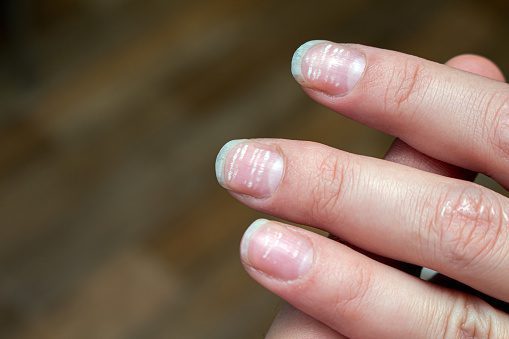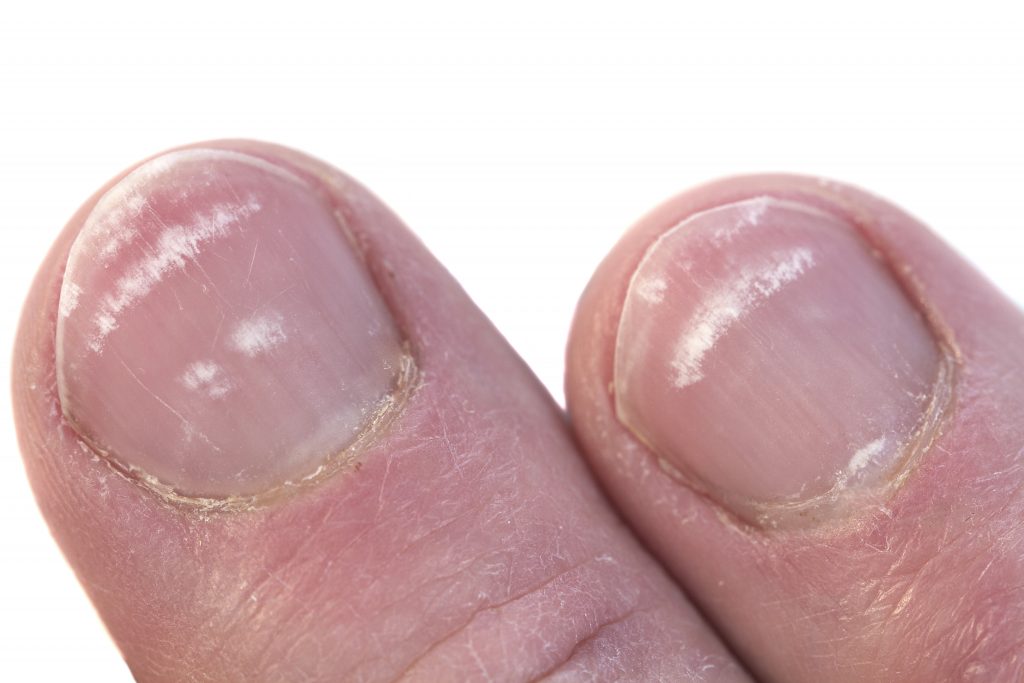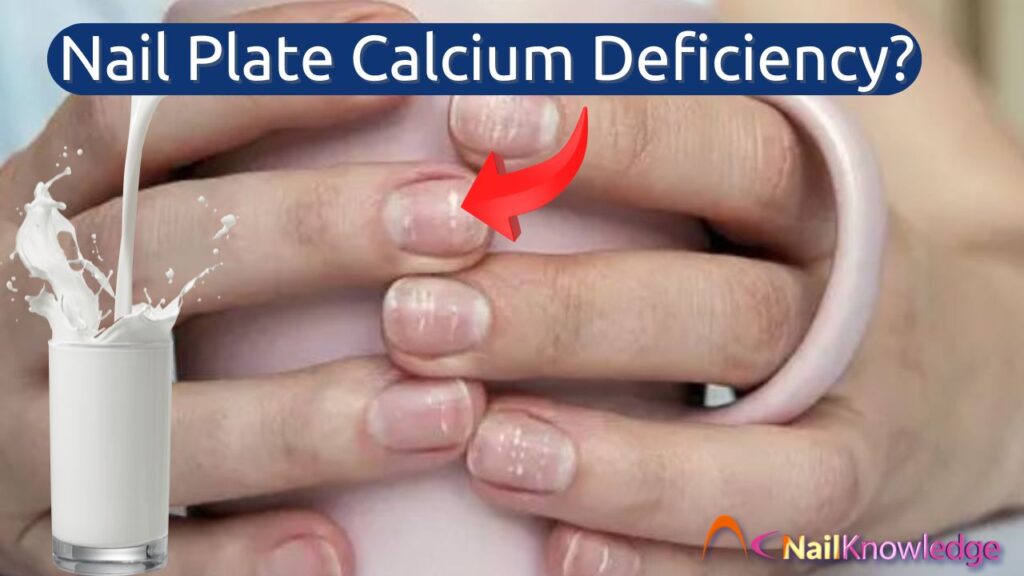Have you ever spotted tiny white marks on your fingernails and thought, “Ah, I must be low on calcium”? You’re definitely not alone. For years, we’ve been told these mysterious specks are the telltale signs of nail plate calcium deficiency, but is there any truth to it?
Cảnh báo tiết lộ nội dung: không đúng.
Let’s break it all down and uncover what your nails are actually trying to tell you, without jumping to conclusions about your milk intake.



Thiếu canxi ở móng tay có phải là vấn đề có thật không?
First things first, let’s talk about what the nail plate actually is. Your nails are made of chất sừng, a strong protein also found in your hair and skin. They grow out from the nail matrix, the area beneath the base of your nail, and gradually harden as they push forward.
Sự thật là những chấm trắng nhỏ đó, được gọi là một phần bệnh bạch móng, are caused by minor trauma to the nail matrix. While those little nail plate cells are travelling from the nail matrix and through the eponychium where the cuticle is attached before those nail plates appear from under the Proximal Nail Fold, they are going through a transformation process. Sometimes, something like an aggressive manicure could possibly cause the problem. Still, according to medical science, it happens when the nail plate cells are supposed to compress and become transparent but (for some reason) they don’t and remain as little, opaque, unfinished nail plate cells.
Dù là trường hợp nào thì cũng có điều gì đó cản trở quá trình hình thành tế bào móng, để lại một vùng mờ nhỏ xuất hiện sau nhiều tuần.
Vì vậy, các đốm trắng trên da bạn không cần phải bổ sung canxi.
Đốm trắng trên móng tay là gì và nguyên nhân gây ra chúng là gì?
White spots within the nail plate, often referred to as partial leukonychia, are usually caused by minor injury to the nail matrix beneath lớp biểu bì. When the matrix is disrupted, some nail cells may be pushed out before they are fully developed. These immature cells appear as pale or white spots as they grow with the nail. Once the injury heals, the nail matrix produces normal cells again. Larger clusters of these underdeveloped cells can create a soft area in the nail, so extra care should be taken when preparing the nail plate for artificial nail products. To be sure you are looking at partial leukonychia, apply a little pressure on the nail plate, and if that white spot remains white, then you are; if the color changes it’s something else.
Thay đổi móng tay và những gì chúng LÀM Nghĩa là
Although calcium isn’t to blame, your nails can still reflect aspects of your health. The key is to know what kinds of changes matter and which ones are just surface-level quirks.
Here’s a quick cheat sheet:
- Đốm trắng: Thường là kết quả của khiếm khuyết trong quá trình nén hoặc chấn thương nhẹ ở hoặc xung quanh màng móng, không phải do thiếu hụt chất dinh dưỡng.
- Các gờ: Các gờ dọc phổ biến theo tuổi tác. Các gờ ngang sâu (Beau’s lines) có thể chỉ ra một căn bệnh trong quá khứ, cú sốc hoặc thậm chí là khoảnh khắc căng thẳng khủng khiếp.
- Mềm hoặc móng tay giòn: Often due to excessive water exposure, frequent handwashing, or harsh nail prep techniques, rather than diet.
- Vàng hóa: Điều này có thể là từ sơn móng tay, psoriasis, alopecia, lichen planus or a nhiễm trùng nấm.
Điều cần lưu ý ở đây là không phải mọi thay đổi ở móng đều liên quan đến dinh dưỡng và chắc chắn không liên quan đến tình trạng thiếu canxi ở móng.
The Truth About Calcium’s Role in Nail Plate Health
To be fair, calcium does have a small supporting role in overall nail health. It contributes to the structure of cells, and an extreme long-term deficiency might affect the quality of growing tissues, including nails. But this is rare in most well-nourished individuals.
Thiếu canxi thường biểu hiện ở những hệ thống quan trọng hơn như xương và răng.
If you’re consuming enough calcium through your diet, such as from dairy, leafy greens, almonds or fortified plant milks, you’re more than likely meeting your body’s needs.
Và nếu móng tay của bạn yếu hoặc bong tróc, thủ phạm có thể là bên ngoài nhiều hơn bên trong. Có thêm 2 yếu tố ở đây:
- If you have a short nail matrix you will have thin nails.
- If you file the nail plate too aggressively during nail prep, you will damage the essential structure of the nail plate needed to maintain its strength and flexibility, causing excessive nail weakness and creating even more flaking & delamination.
Những lầm tưởng phổ biến về tình trạng thiếu canxi ở móng tay
It’s easy to get caught up in old wives’ tales and internet wellness tips, so let’s clear up a few more common myths.
- Myth: Biotin and calcium supplements will fix all nail issues.
Truth: They might help if you have a diagnosed deficiency, but most people won’t see dramatic improvements unless there’s an actual imbalance. - Lầm tưởng: Uống nhiều sữa sẽ giúp móng tay chắc khỏe hơn.
Truth: While milk is a source of calcium, your nails aren’t thirsty for it in the same way your bones are. Your nails do love nail oil, but drinking it will not help. Rub it in gently after applying it behind the free edge of the nail plate, allowing it to run into your lateral nail folds. The warmth created by rubbing will help the oil penetrate your nail plate. - Lầm tưởng: Mọi vấn đề về móng tay đều có nghĩa là chế độ ăn uống của bạn có vấn đề.
Truth: More often, it’s your daily habits, such as biting, picking, washing, or harsh nail prep treatments, that are to blame. - Lầm tưởng: Dũa phần rìa móng theo một hướng sẽ giúp móng không bị tách.
Truth: A 120grit diamond nail file will tear up the free edge of the nail plate regardless of which way you file it. It’s better to use 180-240 grit file applying gentle, even pressure to avoid this happening.
Cách thực sự chăm sóc móng tay của bạn
Instead of chasing the myth of nail plate calcium deficiency, focus on these real-world nail care habits.
Uống nước, uống nước, uống nước: Sử dụng dầu dưỡng móng và da chất lượng cao kết hợp với kem dưỡng da tay hoặc chất tẩy tế bào chết chất lượng cao thường xuyên để móng và da không bị khô và bong tróc.
- Bảo vệ đôi tay của bạn: Đeo găng tay khi lau dọn hoặc rửa bát đĩa để tránh phơi sáng quá mức để tưới nước và hóa chất.
- Lưu trữ đúng cách: Sử dụng giũa có độ nhám 180-240 khi giũa cạnh tự do để tránh gây thêm hư hỏng.
- Don’t pick or bite: It may be a nervous habit, but it’s also one of the quickest ways to damage the nail plate and surrounding skin.
- Ăn một chế độ ăn uống cân bằng: Bao gồm nhiều protein, omega-3, sắt, kẽm, để hỗ trợ móng tay của bạn từ trong ra ngoài. Ma trận móng tay lấy chất dinh dưỡng từ máu và chỉ có máu, chế độ ăn uống của bạn càng tốt, móng tay của bạn càng tốt.
Suy nghĩ cuối cùng về tình trạng thiếu canxi ở móng tay
While it’s tempting to blame white spots or brittle tips on a nail plate calcium deficiency, the science just doesn’t back it up. More often than not, your nails are reacting to the everyday wear and tear they go through. Whether that’s a knock on the table, frequent handwashing, or a particularly aggressive manicure, these things have more of an impact than a glass of milk ever could.
So the next time someone points to your nail and says, “You need more calcium,” feel free to drop a little knowledge. Your nails are complex, yes, but they’re also surprisingly resilient. With the right care and a bit of myth-busting, they’ll stay strong and healthy without needing a trip to the dairy aisle.
Đọc thêm
Think those white spots on your nails mean you need more calcium? Not quite! While it’s a common myth, the truth behind those marks is more complex. Learn what actually causes white spots and lines on nails in our in-depth guide on bệnh bạch móng, đó là gì, tại sao lại xảy ra và nó thực sự có ý nghĩa gì đối với sức khỏe móng tay. Đọc thêm tại đây.


